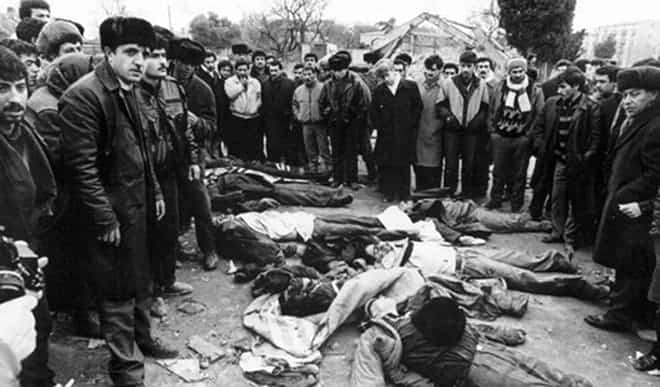The Sumgait Massacres (February 28, 1988)

More than three decades of Azerbaijani anti-Armenian violence and destruction were kicked off by the Sumgait massacres of February 1988, which targeted the population of that seaside town in Azerbaijan as a direct response to the February 20, 1988, vote of the Regional Council of Mountainous Karabagh to unite that historically Armenian region to Soviet Armenia.
Armenians viewed the reform program launched by Soviet leader Mikhail Gorbachev as an opportunity to achieve that union. On February 20, 1988, a demonstration by tens of thousands of Armenians in Lenin (now Renaissance) Square of Stepanakert demanded the unification of Mountainous Karabagh with Armenia. On the same day, the Regional Soviet voted to join Soviet Armenia. The move was staunchly opposed by the Azerbaijani authorities. Gorbachev rejected these claims, invoking Article 78 of the Soviet Constitution, which stated that prior consent of republics was needed to alter their borders.
On February 26, several minor rallies were held at Lenin Square in Sumgait, a leading industrial city 20 miles northwest of Baku, near the Caspian Sea, with a population of 17,000 Armenians (less than 10 per cent of the total). Explicit calls for violence against Armenians and their expulsion from Azerbaijan were heard and the crowds were agitated by fake news of Azerbaijani refugees who had reportedly fled Armenia.
The pogrom of the Armenians of Sumgait started on the evening of February 27. The perpetrators targeted the victims based solely on ethnicity — being Armenian was the only criterion. They had previously obtained the list of addresses of the Armenian residents of the city. While the main participants were adult males and even some women, there were also young students who took part in vandalizing and looting appliances, shoes, and clothing from the Armenians’ homes. The pogrom was marked by atrocities and savagery. The mobs entered the apartment buildings and sought out Armenians where they lived. Some took shelter among their Azerbaijani and Russian neighbors, while others try to disguise as Azeris. Numerous acts of gang rape and sexual abuse were committed in both the apartments and on the city streets.
Many Armenians sought to defend themselves and improvised protection measures, including nailing their doors shut and arming themselves with axes. In some instances, intruding rioters were killed. Calls to ambulance services were handled late or in many cases, unheeded completely. There was no intervention on the part of the Azerbaijani police to stop the perpetrators.
On February 28, a small contingent of troops of the Ministry of Internal Affairs (MVD) entered the city and attempted to quell the rioting without success. The situation worsened and, one day later, more professional military units entered with tanks and armored personnel vehicles. Government forces imposed martial law and curfew, bringing the crisis to an end by March 1. The official death toll released by the Prosecutor General of the Soviet Union (tallies were compiled after lists of named victims) was 32 people (26 Armenians and 6 Azerbaijanis), although other estimates reach up to 400 Armenian dead.
The unexpected violence in Sumgait was widely covered in the Western press. It was greeted with general astonishment in Armenia and the rest of the Soviet Union, since ethnic feuds in the country had been largely suppressed by the government, which had promoted policies and slogans such as proletarian internationalism, peoples’ fraternity, and socialist patriotism to avert such conflicts. The massacre, along with the conflict of Karabagh, presented a major challenge to the reforms being implemented by Soviet leader Mikhail Gorbachev, who was later criticized for his perceived slowness in reacting to the crisis after the third day of the rioting.
By March 1, Soviet troops had effectively quelled the rioting. The Soviet media did not initially report the event and remained largely silent, while the media in Sumgait spoke only on local issues unrelated to the massacre. The Soviet government, initially hesitant to admit that violence had taken place, later downplayed the scale of the event, describing the rioting as perpetrated by “hooligans.”
The authorities arrested 400 men in connection to the massacre and prepared criminal charges for 84 (82 Azerbaijanis, one Russian, and one Armenian). By October 1988, nine men had been sentenced, including Taleh Ismailov, who was sentenced to 15 years in prison, while another 33 were tried. Other sentences were harsher: Ahmad Ahmadov was found guilty and sentenced to death by a firing squad for leading a mob and taking part in the murder of seven people. However, many were sentenced for hooliganism, rather than murder and violence, and set free after a relatively short time.
The pogrom of Sumgait was immediately linked to the genocide of 1915 in the Armenian national consciousness, with Azerbaijanis identified as “Turks.” On the commemoration of April 24 in 1988, a khachkar (cross stone) dedicated to the pogrom victims was placed at the memorial of Tzitzernakaberd in Yerevan. February 28 was designated a public holiday in Armenia in 2005.
